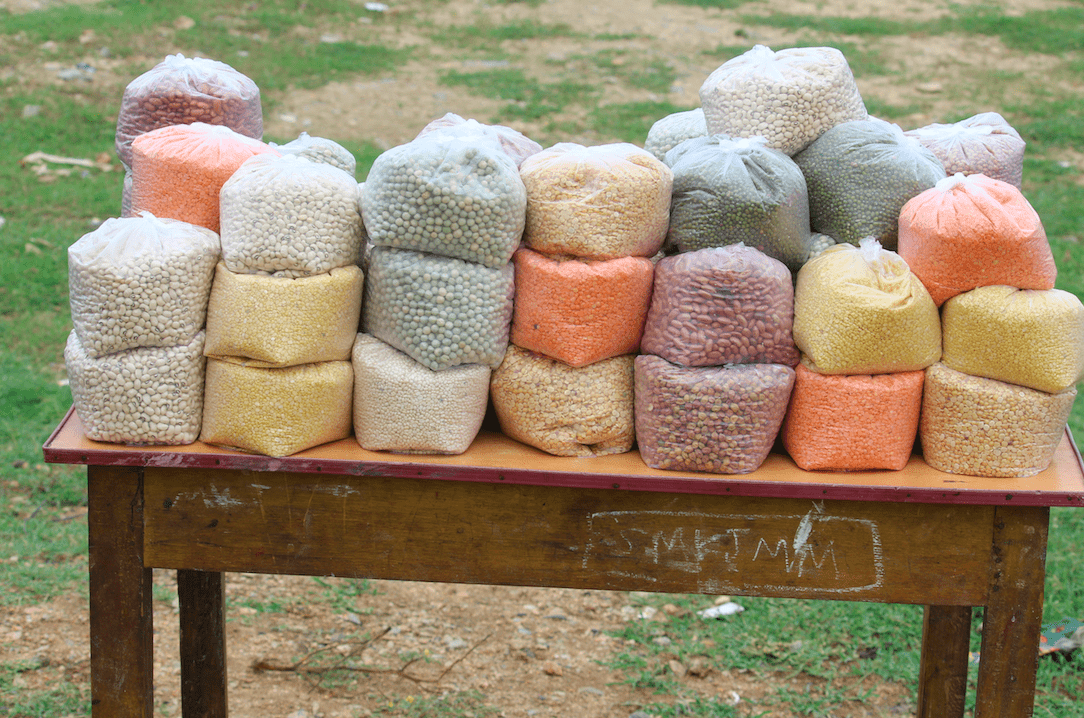
The Ancient Seeds’ Potential to Boost Incomes, Nutrition, and Food Security Levels
The production of pulses, the dry seeds of legume family plants, has trailed behind the general production of cereals and made up only a small percentage of agricultural production globally. In 1970, global pulse production made up 3.5 percent of total cereal production and dropped to 2.8 percent in 2014, according to a 2019 Food and Agriculture Organization of the United Nations report.
Despite often going unnoticed, pulses have tremendous potential to support local incomes, food security, and nutrition. In Northern Ghana, cowpea is a pulse powerhouse thanks to its high resistance to drought and high temperatures, nitrogen-fixing characteristics, and nutrient density that can fight the high prevalence of anemia and stunting. Naturally, our team wondered — how is the local food system for cowpea performing in Northern Ghana? And does the local food system promote regular consumption of cowpea?
To investigate what barriers or opportunities may exist at the household and market levels, ACDI/VOCA conducted a food environment analysis in the Upper East, North East, and Upper West regions of Ghana in August 2020. We focused on analyzing local cowpea production, consumption, vending, and processing.
Unearthing Opportunities to Increase Production and Consumption
Local diets in Northern Ghana are monotonous, consisting primarily of staple cereals, legumes, and local greens. However, cowpea plays a major role in local cuisine, shining in the local dish tubaani, a mix of cowpea flour and water wrapped and cooked in leaves. Our research team found that 52.17 percent of surveyed households consume cowpea at least once weekly, primarily through consuming tubaani.
Cowpea consumption was much higher among those who produce the pulse with 63.33 percent consuming it at least once a week, compared to 31.25 percent among nonproducing households. An added benefit for the cowpea producers was that their cowpea stores lasted an average of 5.33 months, meaning their households had access to the nutritional pulse for almost half the year. Our next question was what prevents the nonproducing households from consuming cowpea more frequently?
Understanding the Local Market for Cowpea
Insights from cowpea vendors and processors provided a glimpse into what might be preventing the growth of the local cowpea market and consumption among nonproducers. Despite cowpea being readily available, vendors noted that its price, though much cheaper than animal source foods, was still too expensive compared to its cereal family members. Cowpea sold for $0.72 per kilogram compared to $0.21 and $0.20 per kilogram for sorghum and maize, respectively.
Cowpea vendors said that low incomes, particularly during COVID-19, affect households’ ability to purchase cowpea regularly. And affecting vendors’ ability to sell cowpea at a lower price was the lower availability of cowpea. Vendors’ inability to purchase cowpea in bulk, due to their lack of financing, also limited their ability to negotiate a better price.
How Increased Production Can Lead to Increased Consumption
Improving local production of cowpea and income-generating opportunities for households could improve prices consumers pay for cowpea as well as their ability to purchase more nutritious foods. Studies from the Statistics, Research and Information Directorate of Ghana’s Ministry of Food and Agriculture show that cowpea production in Northern Ghana is only reaching a maximum of 46 percent of its potential. Production is hindered by the low application of good agricultural practices, such as the use of fertilizers or pesticides, as well as the poor availability of high-quality seeds and few market incentives for expanding production, according to ACDI/VOCA’s research in 2020.
One can learn from the Feed the Future Ghana Agricultural Development and Value Chain Enhancement II (ADVANCE II) Project’s experience in soyabean and maize production. From 2013 to 2018, farmers who engaged with the ADVANCE II Project saw their maize and soyabean gross margins increase from roughly $290 per hectare in 2013 to $781 and $535 per hectare in 2018 for maize and soyabean, respectively. As we recognize World Pulses Day, these successes point to increased production leading to higher incomes and the potential for nutrient-rich pulses like cowpea to finally get their due.
Learn more about the Feed the Future Ghana Agricultural Development and Value Chain Enhancement II Project.
Learn more about our work in Ghana.
Comments







